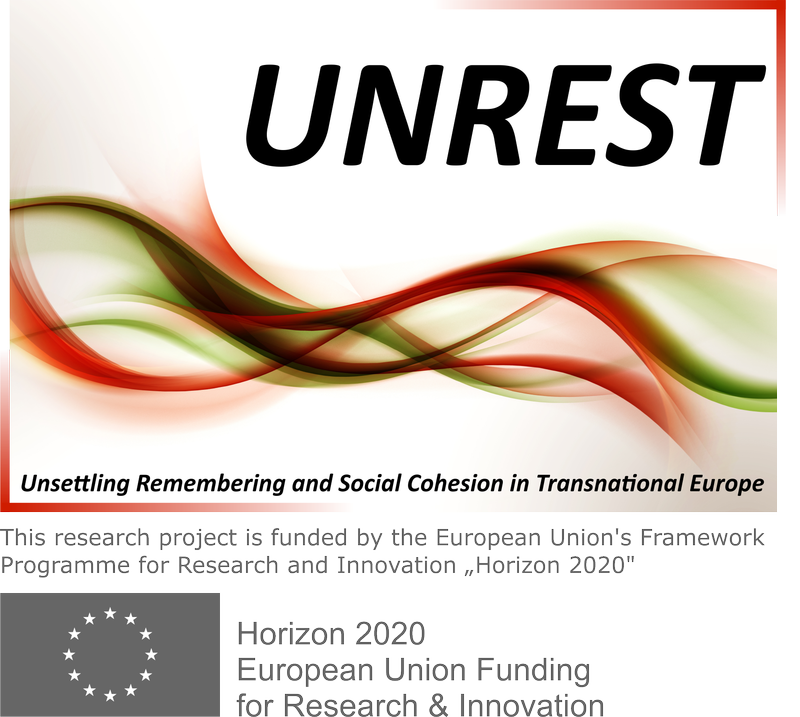UNREST includes the Spanish theatre company Micomicón as a non-academic partner in the development of a theatre performance. Micomicón is one of Spain’s leading theatre companies within the field of experimental, political drama, with extensive experience of bringing the memory of war and the post war repression to the stage. Among Micomicón’s most important works in this field are Los niños perdidos (The Lost Children, 2005) about the case of the Francoist regime’s abduction of republican children, Santa Perpetua (2010) about remembrance and consciousness, and finally El triángulo azul (The Blue Triangle, 2014) about the experience of the Spanish Republicans in the Mauthausen concentration camp. In 2015, El triángulo azul received Spain’s finest theatre prize, the MAX prize, in the categories of best script and best theatre set design. Laila Ripoll and Mariano Llorente, the leading playwrights and artists of Micomicón, have agreed to collaborate on the project with the creation of a play that will challenge the public ethically and politically on questions singled out as demarcation lines between the three major modes of remembering, the antagonistic, the cosmopolitan and the agonistic. The idea of the WP is to stage the play and combine it with a reception analysis among the memory agents engaged in the cases treated in WPs 3+4, broken down by the different types of stakeholders: policy makers, heritage professionals, social groups and popular movements.
We have already agreed with Micomicón on what they call an ‘embryonic idea’ of the performance, i.e. a kind of conceptual, poetic image that can function as a guideline in the subsequent creative process. The conditions given were three: 1) it should decontextualise the geographical setting in order for the spectators to be able to identify with the plot, 2) it should contextualise the conflict historically in a social and political sense, and 3) it must render the most important ethico-political questions open to interpretation.
According to this embryonic idea, the dramatic space will be divided between a forest and a museum. In the European imagery, the forest is an ambiguous place, on the one hand a locus amoenus full of poetry and possibilities, but on the other hand a dangerous place which hides the most terrible secrets underneath the surface. As a second main element of the scenography, the museum will be conceptualised as a place where the objects are alive and speak. The living objects, recognizable as the remains of European armed conflicts, will bring the past into the present through an active process of remembering on stage and allude to the massacres and crimes which took place in Europe during the 20th Century.
Micomicón will work on the creation of the play during the first year of the project, and in the second year it will be staged in front of an audience in Spain. A reception analysis will be carried out and a video version recorded. After having edited the recording and translated the text, the video version will be screened in front of 3 chosen audiences in Spain, Bosnia and Poland. Each of these audiences will include 3 stakeholder groups: policy-makers (12), cultural heritage professionals (12) and memory activists (12). Each of the 3 total screenings will integrate a total audience sample of 36 members. The reception analysis of the video screening will be compared to the analysis of the live performance, and the reception analysis of each of the different countries will be compared to the others in relation to interpretative biases related to the stakeholder group belonging, age and gender.
Scholarly studies of live theatre audiences have been discontinuous and are still underdeveloped. They usually focus on the performance potential to involve the theatre visitors (Fischer-Lichte 2004), but studies of the audience’s experiences as such are rare. When they do appear, they make use of surveys based on closed questions that only allow positive or negative answers ranged in x-point scales (Barker 2003). UNREST considers this methodology insufficient and based on biased questionnaires that leave out audiences’ ‘feeling’ and ‘responsibility’ (ability to respond and reflect).
Instead, this project will develop an innovative methodology consisting of qualitative group conversations and qualitative interviews. The former will consist of brainstorming sessions conducted immediately after the performance with the aim of grasping the audience’s impressions and feelings collectively. The latter will test how each of the groups established by the reception analysis’ setup (stakeholders, gender, age and culture) respond to the open ethico-political challenges concerning the interpretation of the grey zones between e.g. guilt, justice and revenge or the relation between perpetrators, by-standers and victims.
